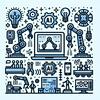Industrial Robotics Weekly: Manufacturing & AI Updates

207 épisodes

Bots Behaving Badly: Rogue Robots Spark Factory Floor Drama
05/1/2026 | 2 min
This is you Industrial Robotics Weekly: Manufacturing & AI Updates podcast.Welcome to Industrial Robotics Weekly, your go-to source for manufacturing and artificial intelligence updates. As we kick off 2026, factory floors worldwide are buzzing with automation breakthroughs that promise smarter, faster production.Gray Matter Robotics highlights how AI-powered robots are slashing downtime through predictive maintenance, boosting throughput by running nonstop, and cutting errors for up to twenty percent less rework in automotive lines. Evocon reports that eighty-nine point four percent of manufacturers prioritize digital transformation this year, with agentic AI—systems that reason, plan, and act autonomously—now managing supply chains and optimizing shifts, as noted in Forbes via their analysis.In warehouse automation, Hy-Tek predicts robotic de-palletizing and pallet-building will explode, handling mixed loads with AI vision for higher throughput and safer ergonomics, while Robotics-as-a-Service models make it affordable for mid-sized operations via flexible subscriptions. Novus Hi-Tech forecasts industrial and warehouse robots driving sixty to sixty-five percent of global market growth, led by Asia-Pacific adopters like China and rising stars India, fueled by reshoring and e-commerce demands.Case in point: Tesla's Optimus humanoid robots tackle repetitive tasks in car manufacturing, per Gray Matter, enhancing human-robot collaboration with intuitive safety features. Productivity metrics shine too—Omdia notes AI and software-defined architectures under geopolitical pressures will regionalize factories for resilient efficiency, with Deloitte projecting physical AI robots doubling adoption to twenty-two percent among leaders.Safety advances via cobots allow seamless worker teamwork, minimizing risks in electronics and aerospace, while ROI studies from Brightpick show manufacturing leading automation as domestic output per worker surges amid tariffs.Practical takeaways for listeners: Audit your floor for real-time data gaps to enable connected factories, pilot RaaS for low-risk scaling, and train teams on low-code robot programming to cut setup times.Looking ahead, expect cloud robotics, digital twins, and humanoid pilots to democratize high-precision work, reshaping global supply chains toward lights-out agility.Thank you for tuning in, listeners—come back next week for more. This has been a Quiet Please production, and for me, check out Quiet Please Dot A I.For more http://www.quietplease.aiGet the best deals https://amzn.to/3ODvOtaThis content was created in partnership and with the help of Artificial Intelligence AI

Optimus Robots Strutting Their Stuff on Tesla Factory Floors as AI Surges in 2026
04/1/2026 | 2 min
This is you Industrial Robotics Weekly: Manufacturing & AI Updates podcast.Welcome to Industrial Robotics Weekly, your source for manufacturing and artificial intelligence updates. As we kick off 2026, factory automation is surging, with industrial and warehouse robotics poised to drive sixty to sixty-five percent of global market growth, according to Novus Hi-Tech reports. Manufacturers are embracing AI-powered robots for faster production cycles, predictive maintenance that slashes downtime, and error reduction, as detailed by Gray Matter Robotics.A standout development comes from IDC's 2026 Manufacturing FutureScape, predicting over forty percent of production scheduling systems will integrate AI for autonomous operations by year's end. Meanwhile, Deloitte's outlook highlights eighty percent of executives planning major smart manufacturing investments, focusing on automation hardware and agentic AI to boost output and agility. In warehouse automation, Brightpick forecasts manufacturing as the primary driver, fueled by reshoring and Robots-as-a-Service models gaining traction.Case in point: Tesla's Optimus humanoid robots are advancing human-robot collaboration in automotive lines, enabling safer, intuitive interactions while handling repetitive tasks. Productivity metrics show AI robotics optimizing energy use and enabling small-batch flexibility, with Omdia noting software-defined factories accelerating under geopolitical pressures for resilient operations.Worker safety improves through smarter cobots and bidirectional skills transfer, where IDC warns firms ignoring this face twenty percent higher downtime. Cost-wise, hyperautomation from MSRCosmos cuts operational expenses via real-time workflow optimization, delivering strong returns on investment.Practical takeaways for listeners: Audit your processes for AI upgrades, pilot Robots-as-a-Service to test scalability, and invest in workforce reskilling platforms to foster collaboration.Looking ahead, expect humanoid robots dominating pilots, cloud-integrated digital twins, and agentic AI simulating processes for precision. By 2029, thirty percent of factories will run software-defined controls, per IDC, transforming manufacturing into intelligent, efficient ecosystems.Thank you for tuning in, listeners. Come back next week for more, and this has been a Quiet Please production—for more, check out Quiet Please Dot A I.For more http://www.quietplease.aiGet the best deals https://amzn.to/3ODvOtaThis content was created in partnership and with the help of Artificial Intelligence AI

Robo Gossip: Factories Flirt with AI, Ditch Dumb Bots for Brainy Droids!
03/1/2026 | 3 min
This is you Industrial Robotics Weekly: Manufacturing & AI Updates podcast.Welcome to Industrial Robotics Weekly, where we bring you the latest developments in manufacturing automation and artificial intelligence. As we enter 2026, the manufacturing landscape is undergoing a fundamental transformation driven by intelligent automation and agentic AI systems.The shift happening right now represents a pivotal moment for industrial operations. According to Deloitte's 2026 Manufacturing Industry Outlook, 80 percent of manufacturing executives plan to invest 20 percent or more of their improvement budgets in smart manufacturing initiatives. This includes automation hardware, data analytics, sensors, and cloud computing infrastructure. The focus has moved decisively beyond basic automation toward what industry analysts describe as the era of intelligent efficiency.Physical AI and humanoid robotics are transitioning from prototype demonstrations into production reality. Unlike traditional industrial robots programmed for single repetitive tasks, these Physical AI agents can perceive, understand, and navigate unstructured environments. IDC's 2026 Manufacturing Industry FutureScape predicts that by 2029, 30 percent of factories will configure and manage control systems centrally using software-defined automation platforms. This represents a dramatic shift in how manufacturers approach operational control.The productivity gains are substantial and measurable. Gray Matter Robotics reports that AI-powered robots running continuously reduce production cycle times while enabling predictive maintenance that identifies potential failures before they cause expensive downtime. Manufacturers are simultaneously optimizing energy consumption and material utilization through data-driven systems. Real-time data now connects the plant floor directly to enterprise systems, enabling instantaneous decision-making.Human-robot collaboration is evolving into what experts call Collaboration 2.0, emphasizing intuitive communication and safer mechanical movements. According to the Manufacturing Leadership Council, nearly 22 percent of manufacturers plan to implement physical AI within two years, more than doubling the current adoption rate. This reflects growing confidence in autonomous systems that augment rather than replace human workers.The financial case is compelling. Companies deploying hyperautomation report higher agility, lower operational costs, and improved business continuity. Robots-as-a-Service models are democratizing access to advanced automation by reducing upfront capital requirements. For manufacturers facing the global labor shortage, automation has become the primary competitive lever over the next three years.The practical takeaway for your operations is clear: investment in AI-driven automation and software-defined factory architectures should be prioritized. Facilities implementing these technologies today will establish performance benchmarks that competitors will struggle to match. Begin with predictive maintenance systems and real-time data integration to capture immediate efficiency gains.Looking ahead, cloud robotics with integrated Internet of Things capabilities will enable faster self-learning and remote management. Digital twins will simulate entire manufacturing processes to identify optimization opportunities specific to your operations.Thank you for tuning in to Industrial Robotics Weekly. Join us next week for more updates on manufacturing innovation and automation trends. This has been a Quiet Please production. For more information, visit Quiet Please dot AI.For more http://www.quietplease.aiGet the best deals https://amzn.to/3ODvOtaThis content was created in partnership and with the help of Artificial Intelligence AI

Industrial AI Robots Invade Factories: Efficiency Skyrockets, Jobs on the Line?
02/1/2026 | 2 min
This is you Industrial Robotics Weekly: Manufacturing & AI Updates podcast.Welcome to Industrial Robotics Weekly, your source for the latest in manufacturing and AI updates. The industrial AI robotics market is surging with a projected annual growth rate of 23.24 percent, reaching 36.11 billion dollars by 2030, according to Gray Matter Robotics. This boom reflects accelerating trends in manufacturing automation, where AI integration drives smarter factories through advanced sensors for real-time environmental awareness, dexterous actuators for precise tasks, and sophisticated control systems enabling autonomous decisions.Recent news highlights Tesla's push toward humanoid robots like Optimus for automotive assembly, tackling repetitive tasks while boosting precision in self-driving car production, as noted by Gray Matter Robotics. Meanwhile, IDC predicts that by 2026, over 40 percent of manufacturers will upgrade production scheduling with AI for autonomous processes, and Brightpick forecasts manufacturing as the primary driver of U.S. automation amid reshoring efforts fueled by supply chain fragility.In warehouse automation and process optimization, hyperautomation combines AI, machine learning, and robotic process automation to predict failures and manage supply chains, slashing downtime and costs, per MSRCosmos. Case studies from aerospace show AI robots enhancing high-precision assemblies, yielding faster cycles, predictive maintenance, and optimized resource use. Deloitte reports 80 percent of executives plan major smart manufacturing investments, improving output and productivity.Worker safety advances via Human-Robot Collaboration 2.0, with intuitive interfaces and bidirectional skills transfer; IDC warns firms ignoring this face 20 percent higher downtime. Cost analysis reveals Robots-as-a-Service models democratizing access, lowering entry barriers and enhancing ROI through scalability.Practical takeaways for listeners: Assess your workflows for AI pilots, invest in workforce upskilling for hybrid roles blending tech and craftsmanship as urged by Lee Contracting, and explore low-code platforms for quick automation wins.Looking ahead, agentic AI and physical AI robots promise software-defined factories and cloud-integrated digital twins by 2029, per IDC, ushering in resilient, efficient operations despite geopolitical shifts splitting supply chains, as Brightpick observes.Thank you for tuning in, listeners. Come back next week for more. This has been a Quiet Please production—for more, check out Quiet Please Dot A I.For more http://www.quietplease.aiGet the best deals https://amzn.to/3ODvOtaThis content was created in partnership and with the help of Artificial Intelligence AI

Robots Raid Factories: Tesla's Optimus & Figure's Bots Stealing Jobs?
31/12/2025 | 2 min
This is you Industrial Robotics Weekly: Manufacturing & AI Updates podcast.Welcome to Industrial Robotics Weekly, your source for the latest in manufacturing and AI updates. The global operational stock of industrial robots has reached about 4.66 million units, up nearly 9 percent from last year, according to Robotnik's 2025 outlook, making them essential for boosting productivity in factories worldwide.In manufacturing automation trends, electronics leads with 128,899 new robot installations in 2024, while automotive sees steady but slightly declining deployments, and metals surges ahead. Deloitte's 2025 Smart Manufacturing Survey reveals 92 percent of manufacturers view smart operations as the key to competitiveness, with 41 percent prioritizing factory automation hardware next. AI integration shines through collaborative robots, or cobots, that safely work alongside humans, optimizing complex tasks via real-time data analysis. Autonomous mobile robots from firms like Robotnik cut warehouse transport times by up to 30 percent, as seen in recent expansions into new markets.Recent news highlights Tesla's Optimus and Figure's AI humanoids deploying on small scales in factories by year's end, per WiredWorkers, promising versatile human-like collaboration. Meanwhile, Roland Berger notes a 2025 slowdown in automation growth after 2024's dip, urging focus on flexible systems. The International Federation of Robotics projects 575,000 new installations globally this year, doubling demand over the past decade.Productivity metrics show robots enhancing precision in assembly, welding, and handling, reducing errors and enabling small-batch customization. Worker safety improves with cobots and vision AI for quality control, minimizing risks in hazardous areas. Cost-wise, plug-and-produce solutions deliver fast returns on investment, especially for small firms, while IIoT and cloud analytics drive efficiency gains.For practical takeaways, audit your lines for cobot fits in repetitive tasks, invest in sensors for data capture, and pilot AMRs for logistics to see 20 to 30 percent time savings. Upskill teams on AI tools to handle transformations smoothly.Looking ahead, expect AI-driven digital twins, edge computing, and humanoids to usher in hyper-flexible, connected factories, reshaping manufacturing for sustainability and agility.Thanks for tuning in, listeners. Come back next week for more. This has been a Quiet Please production—for me, check out Quiet Please Dot A I.For more http://www.quietplease.aiGet the best deals https://amzn.to/3ODvOtaThis content was created in partnership and with the help of Artificial Intelligence AI
Plus de podcasts Actualités
Podcasts tendance de Actualités
À propos de Industrial Robotics Weekly: Manufacturing & AI Updates
Écoutez Industrial Robotics Weekly: Manufacturing & AI Updates, Laurent Gerra ou d'autres podcasts du monde entier - avec l'app de radio.fr

Obtenez l’app radio.fr gratuite
- Ajout de radios et podcasts en favoris
- Diffusion via Wi-Fi ou Bluetooth
- Carplay & Android Auto compatibles
- Et encore plus de fonctionnalités
Obtenez l’app radio.fr gratuite
- Ajout de radios et podcasts en favoris
- Diffusion via Wi-Fi ou Bluetooth
- Carplay & Android Auto compatibles
- Et encore plus de fonctionnalités


Industrial Robotics Weekly: Manufacturing & AI Updates
Téléchargez l’app,
Écoutez.







































